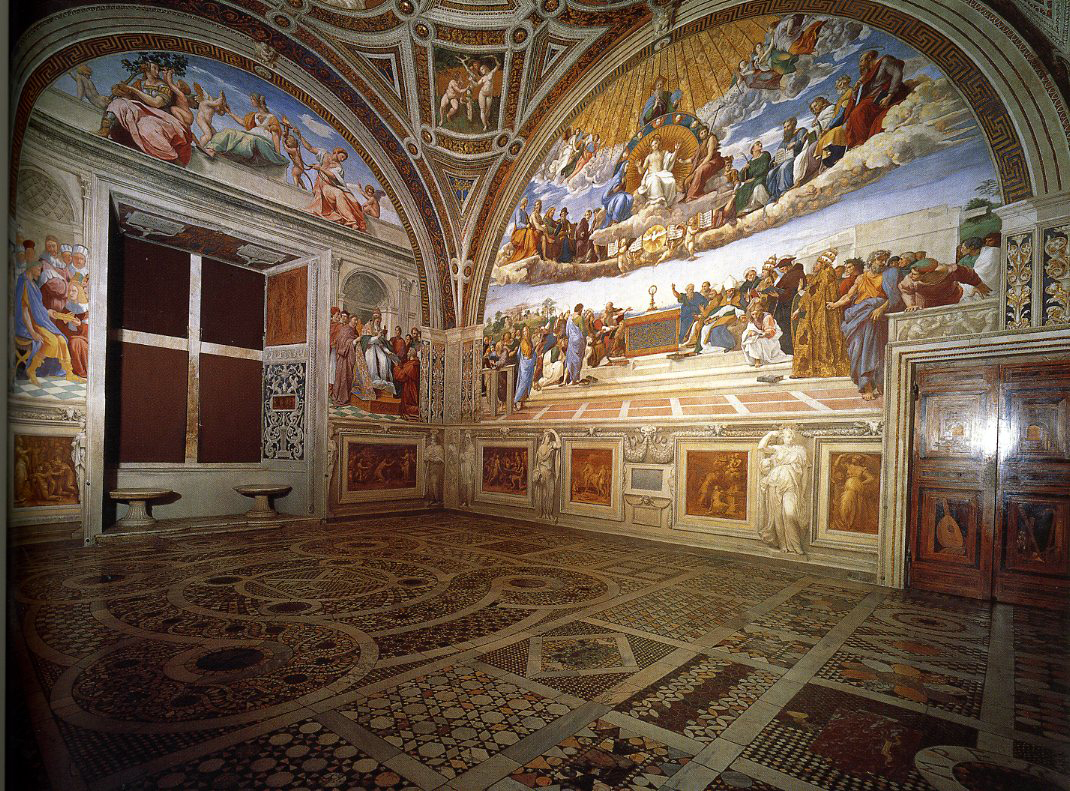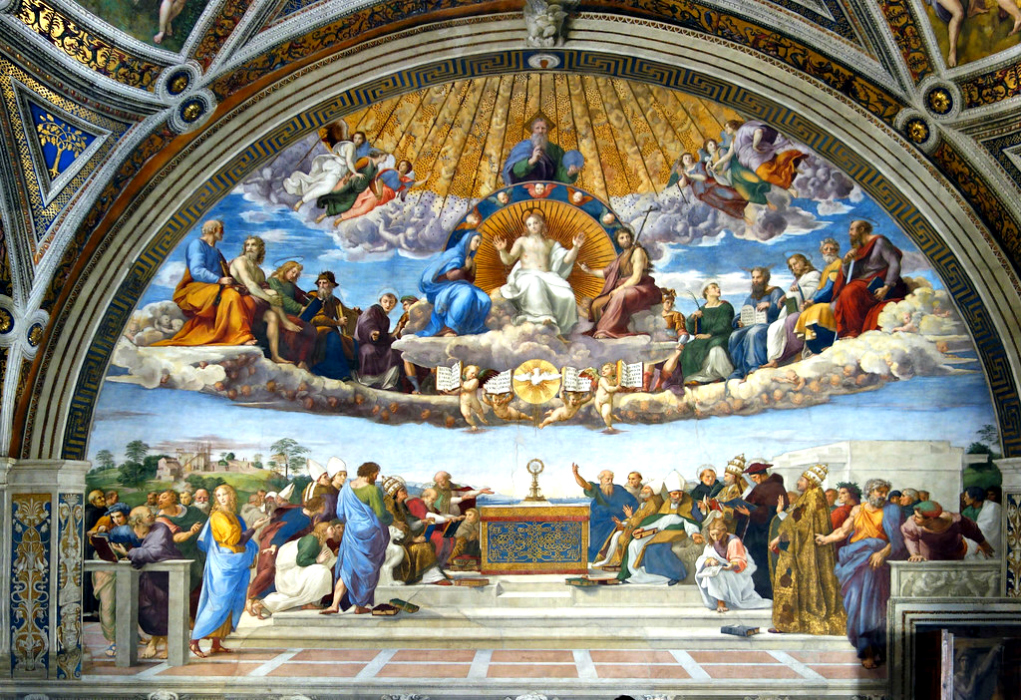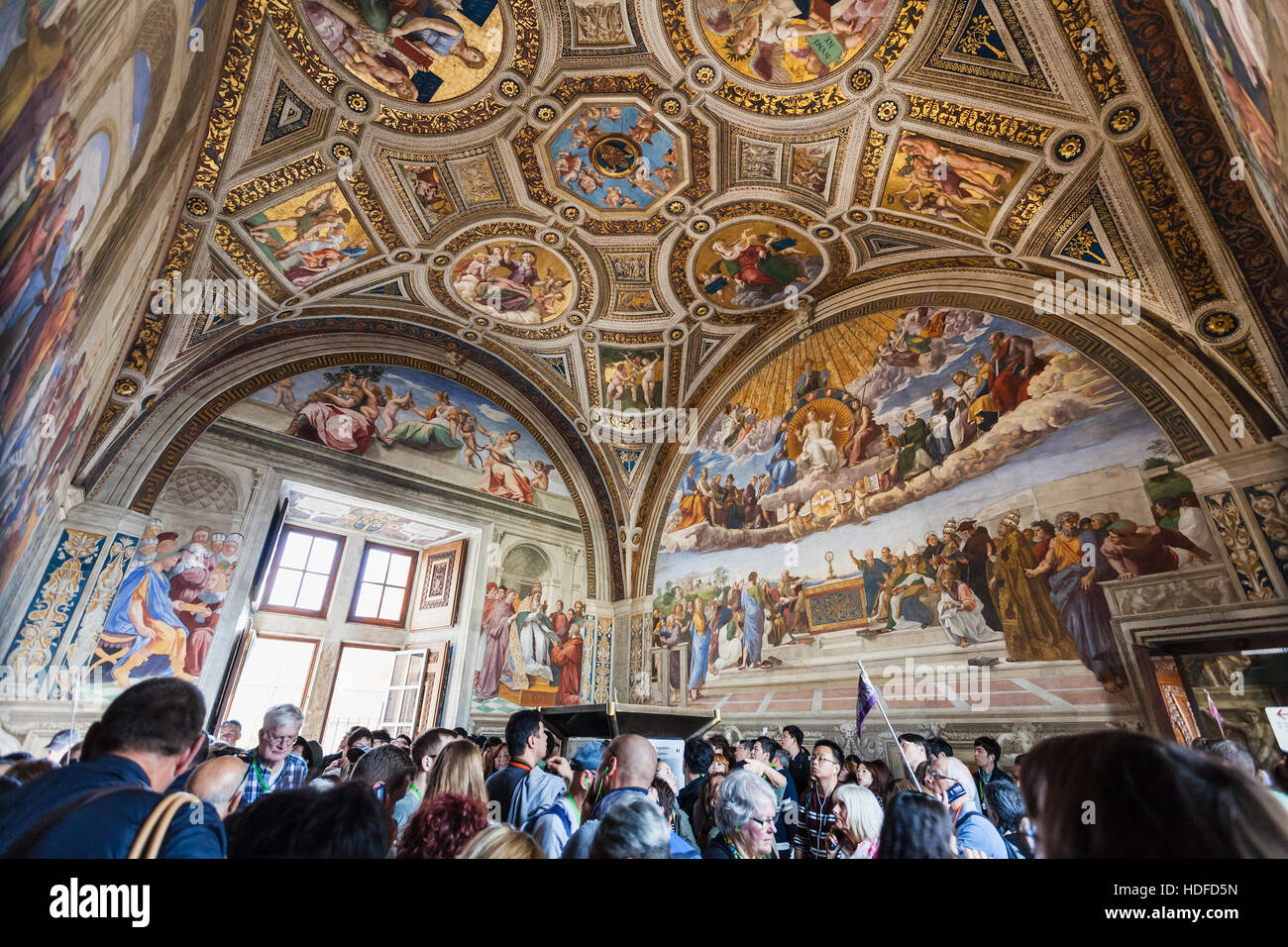
Stanza della Segnatura ceiling frescoes
The frescoes of The Stanza della Segnatura, completed from 1508 - 1511, are perhaps, Raphael's best-known work. All the walls and the ceiling are decorated with frescoes painted by Raphael, for the most part, unaided by his numerous assistants and students. One long wall displays Disputa ( Disputation of the Holy Sacrament ), which shows a.

View of the Stanza della Segnatura by RAFFAELLO Sanzio
The Stanza della Segnatura in the Vatican's Stanze di Raffaello (Raphael Rooms) is a papal apartment frescoed by Raphael with the School of Athens and other masterpieces. The original cartoon for Raphael's School of Athens —note the lack of Heraclitus/Michelangelo in the center. The second Raphael Room is perhaps the highlight, the Stanza.

sauvage27 STANZA DELLA SEGNATURA La disputa del Sacramento, La
Stanza della Segnatura La Stanza della Segnatura contiene i più famosi affreschi di Raffaello: essi costituiscono l'esordio del grande artista in Vaticano e segnano l'inizio.Leggi Tutto. Navigazione - Stanza della Segnatura. Disputa del SS. Sacramento; Scuola di Atene; Virtù Cardinali e Teologali e la Legge; Parnaso; Volta;

Stanza della Segnatura, one of the four Stanze di Raffaello , Vatican
Raphael Rooms, also called the Stanze, were originally created as a suite of apartments for Pope Julius II della Rovere. The Pope commissioned Raphael and his studio in 1508-1509 to decorate the interiors of rooms. The Stanze is located right above Alexander's Borgia Apartment on the third floor of the Palace of the Vatican, overlooking the.

History of Western Art, Architecture, and Design Raphael's Stanza
The Stanza della Segnatura and its painted program: the Library of Julius II 2. The inventor of the program: ambiguities and uncertainties 3. The Pope's Librarian, Tommaso Inghirami: portrait of a Humanist 4. The ceiling: the birth of the disciplines and the triumph of their protector 5. The geography of the Stanza della Segnatura 6.

Stanza Della Segnatura — Stephanie Storey
ATTHE STANZA DELLA SEGNATURA (1508-11 CE} CLARE P. FRANK AND WILLIAM A. FRANK A Room with Many Conversations The Stanza della Segnatura is an elegant, modest-sized room on the second floor of the Vatican palace (now the Musei Vaticani) designed to house Pope Julius Il's personal library.

Raffaello Stanze Vaticane View of the Stanza della Segnatura
La Stanza della Segnatura contiene i più famosi affreschi di Raffaello: essi costituiscono l'esordio del grande artista in Vaticano e segnano l'inizio del pieno Rinascimento. L'ambiente prende il nome dal più alto tribunale della Santa Sede, la "Segnatura Gratiae et Iustitiae", presieduto dal pontefice e che usava riunirsi in questa sala.

Stanze di Raffaello Stanzen, Kunstgeschichte, Raffaello
Written by: Meryam Joobeur. Produced by: Maria Gracia Turgeon, Habib Attia. Mohamed is deeply shaken when his oldest son Malik returns home after a long journey with a mysterious new wife. 'Philosophy, from the 'Stanza della Segnatura'' was created in 1511 by Raphael in High Renaissance style. Find more prominent pieces of allegorical.

Stanza della Segnatura
The Stanza della Segnatura was Julius II's library, and the frescoes Raphael executed there illustrate the themes of theology, philosophy, jurisprudence, and poetry, themes that reflect the content of the pope's books. Raphael's decoration of the stanze continued under Julius's successor, Leo X (r. 1513-21). The rooms vary widely in.
Stanze Vaticane Quali Stanze ha affrescato Raffaello in Vaticano
This site is an exploration of Raphael's Stanza della Segnatura in the Vatican Palace painted in the years 1508 to 1511 during the papacy of Julius II. Each of the four frescoes in the room as well as the painted ceiling are treated in individual sections: (1) Ceiling, (2) The Disputa, (3) The School of Athens, (4) Parnassus, and (5) Jurisprudence.

Raffaello e le Stanze Vaticane la Stanza della Segnatura La Citta
Stanza della Segnatura. The first of Pope Julius II's rooms in the papal appartments to be decorated with Raphael's frescoes was the study in which the "Signatura gratiae" tribunal was originally located (Stanza della Segnatura). The artist's concept brings into harmony the spirits of Antiquity and Christianity.

Raphael Ceiling of the Stanza della Segnatura Art Print Poster 12x18
La Stanza della Segnatura è uno degli ambienti delle Stanze di Raffaello nei Musei Vaticani. Fu il primo ad essere decorato da Raffaello Sanzio, tra il 1508 e il 1511 Storia. L'ambiente prende il nome dal più alto tribunale della Santa Sede, la "Segnatura Gratiae et Iustitiae" (Segnatura di.

The Parnassus, detail of Homer, Dante and Virgil, in the Stanze della
Other articles where Stanza della Segnatura is discussed: Raphael: Last years in Rome of Raphael: The decoration of the Stanza della Segnatura was perhaps Raphael's greatest work. Julius II was a highly cultured man who surrounded himself with the most illustrious personalities of the Renaissance. He entrusted Bramante with the construction of a new basilica of St. Peter to replace the.

Stanza della Segnatura Stanze di Raffaello ai Musei Vatica… Flickr
Other articles where Stanza della Segnatura is discussed: Il Sodoma:.Pope Julius II in the Stanza della Segnatura in the Vatican. Although Raphael worked on the same ceiling in 1509, he left some of Sodoma's ceiling decoration, including mythological figures and Roman military scenes, intact. About 1510 Sodoma again utilized mythological figures for ceiling decoration in Via del Casato, a…

Stanza della Segnatura ceiling frescoes
Stanza della Segnatura. The Stanza della segnatura ("Room of the Signatura") was the first to be decorated by Raphael's frescoes. It was the study housing the library of Julius II, in which the Signatura of Grace tribunal was originally located.

VATICAN, ITALY NOVEMBER 2, 2016 Visitors in Stanza della segnatura
School of Athens, fresco (1508-11) painted by artist Raphael, in the Stanza della Segnatura, a room in Pope Julius II's private apartments in the Vatican. It is perhaps the most famous of all of Raphael's paintings and one of the most significant artworks of the Renaissance.. Raphael was called to Rome toward the end of 1508 by Julius II at the suggestion of the architect Donato Bramante.